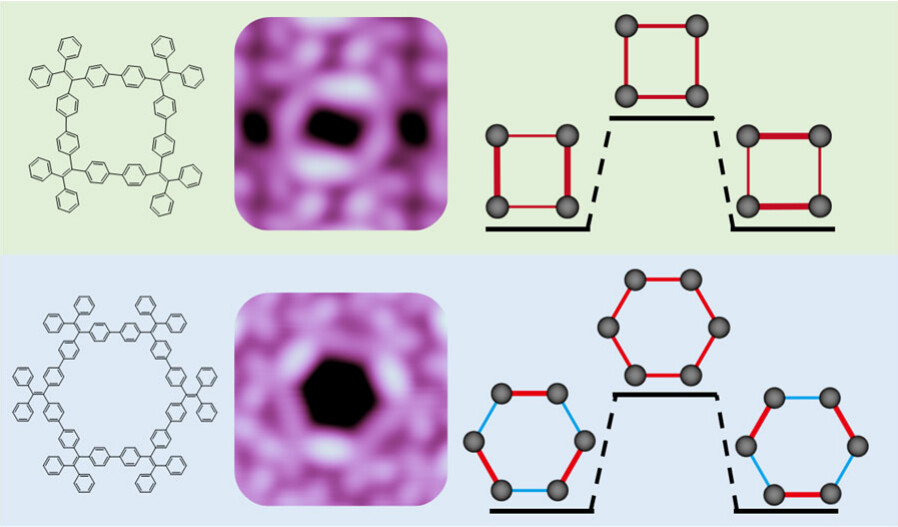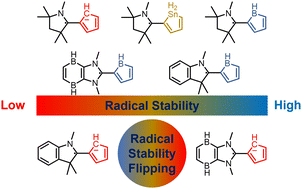Nature Chemistry





Activation of dinitrogen (N2) under mild conditions has been a particularly challenging project for decades, owing to the highly strong N≡N triple bond. In recent years, the main group species have emerged as a prominent strategy in the field of dinitrogen activation, but the reported examples remain particularly rare compared with transition metal complexes. Herein, we performed a comprehensive density functional theory (DFT) calculation of N2 activation by boron radical cations.

Combining aromaticity and hyperconjugation, two important concepts in organic chemistry, leads to hyperconjugative aromaticity, which was first proposed by Mulliken in 1939. However, previous studies on hyperconjugative aromaticity have mainly focused on substituents containing either main-group elements (group 14) or transition metals in groups 7, 9, 10, and 11. In this study, we perform density functional theory (DFT) calculations on cyclopentadiene and pyrrolium derivatives containing groups 13, 15 and 16 substituents to examine the possibility of achieving hyperconjugative aromaticity.

Tetraphenylethylene (TPE) is a prototype aggregate-induced emission molecule. TPE-based conjugated macrocycles exhibit unique optical properties due to their peculiar cyclic topology. Because the symmetry of macrocycles strongly affects their photophysical properties, here we report a single-molecule study of the structures and orbitals of two TPE-based macrocycles of (C26H18)4 and (C26H18)6. Using scanning tunneling microscopy and spectroscopy, we discover that both macrocycles undergo spontaneous symmetry breaking in their conformations and frontier orbitals.

Hyperconjugative aromaticity, an integration of two chemical concepts, aromaticity and hyperconjugation, was first proposed in 1939. Recently, breaking through the main group elements, the hyperconjugative aromaticity has been successfully extended to the transition metal system, including groups 7, 9, 10, and 11 organometallic substituents. Here, we demonstrate that the missing group 8 transition metal substituents also possess a powerful ability to induce hyperconjugative aromaticity in cyclopentadiene via density functional theory calculations.

The suitability of electron-rich bis-silylenes, specifically the neutral chelating [SiII(Xant)SiII] ligand (SiII = PhC(NtBu)2Si, Xant = 9,9dimethylxanthene) and the anionic [SiII(NAcrid)SiII)]‒ pincer ligand (NAcrid = 2,7,9,9-tetramethylacridane), has been successfully probed to stabilize monovalent bis-silylene-supported aluminium complexes (aluminylenes).

In most Suzuki-Miyaura carbon-carbon cross-coupling reactions, the borabicyclo[3.3.1]nonane scaffold (9-BBN) only serves as an auxiliary facilitating the transmetalation step and thus is transformed into by-products. There are rare examples where the 9-BBN derivatives serve as the potentially diverse C8 building blocks in cross-coupling reactions. Herein, we report a cobalt-catalyzed migratory carbon-carbon cross-coupling reaction of the in situ formed 9-BBN ate complexes to afford diverse aryl- and alkyl-functionalized cyclooctenes.

Aromaticity, as a classical and fundamental concept in chemistry, can enhance thermodynamic stability. In sharp contrast, a previous study showed that antiaromaticity rather than aromaticity can enhance the radical stability of α-methyl heterocyclic compounds. Here, we demonstrate a similar antiaromaticity-promoted radical stability when the methyl group is replaced by five-membered (alkyl)(amino)cyclics (AACs). More interestingly, when an AAC is fused with an antiaromatic ring, the radical stability could be either reduced or enhanced, depending on the spin population.

Ring contraction of metallacyclobutadiene to metallacyclopropene is rare because of the increasing strain from a four-membered ring to a three-membered one. Here we demonstrate a new series of reactions of metallabenzocyclobutadiene to metallabenzocyclopropene via density functional theory calculations. The results suggest that these reactions are thermodynamically favorable ranging from −17.4 to −29.4 kcal mol–1, and a low reaction barrier (10.3 kcal mol–1) is achieved when the metal center is Ru and the ligands are one cyanide and one chloride.

Aromaticity is a fundamental concept in organic chemistry. Hyperconjugative aromaticity, also known as hyperconjugation-induced aromaticity, has evolved from its origin from main group substituents to transition metal analogues, establishing itself as an important category of aromaticity. Additionally, aromatic compounds comprising two sp3-carbon atoms have recently been reported both experimentally and computationally. However, what is the maximum number of sp3-hybridized atoms needed to maintain hyperconjugative aromaticity?

The activation of C–F bonds has long been regarded as the subject of research in organometallic chemistry, given their synthetic relevance and the fact that fluorine is the most abundant halogen in the Earth’s crust. However, C–F bond activation remains a largely unsolved challenge due to the high bond dissociation energies, which was historically dominated by transition metal complexes. Main group elements that can cleave unactivated monofluorobenzene are still quite rare and restricted to s-block complexes with a biphilic nature.
Copyright © 2026,
Theme Originally Created by Devsaran
